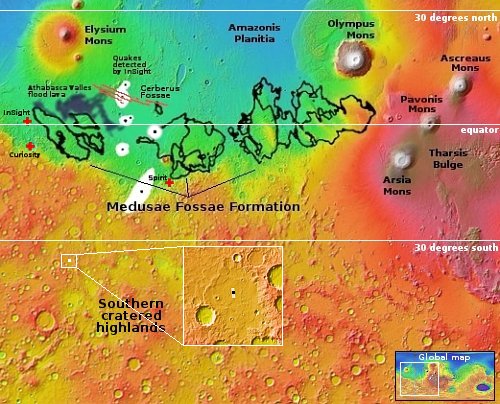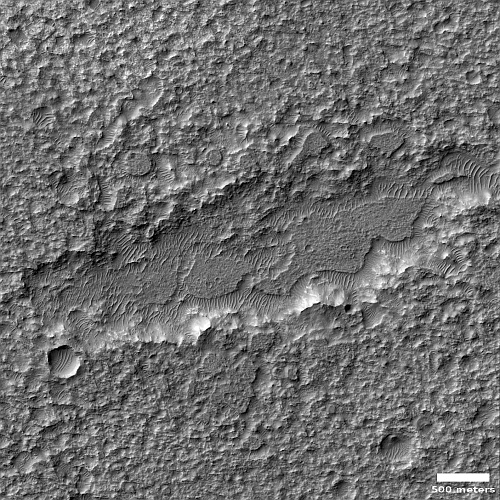Ancient volcano vent in the Martian southern cratered highlands?
The nature of today’s cool image suggests both ancient and more recent geological activity, each coming from entirely different sources but both helping to shape the alien Martian surface.
The picture to the right, rotated, cropped, reduced, and sharpened to post here, was taken on March 13, 2023 by the high resolution camera on Mars Reconnaissance Orbiter (MRO). It shows what the science team has labeled an “elongated depression,” sitting in the middle of a relatively flat but very rough stippled circular plain about 60 miles in diameter. An MRO context camera picture, taken on February 19, 2012, covered the central strip of this plain, and shows that its surface is equally rough and stippled everywhere, with only a few craters and one or two slight changes in elevation.
So, how does this feature tell us both about the ancient and recent geological history of this spot on Mars?

The black dot in the center of the inset on the overview map to the right shows us the depression’s location in the southern cratered highlands of Mars. As cratered as the highlands are, however, this flat plain is mostly devoid of craters, suggesting it might be an ancient flood lava plain. This depression appears to have been the main outlet vent for that lava, as the highest thin lava layers appear centered on it.
Because this particular location is so smooth, it suggests the lava event likely occurred after the heavy bombardment period in the early solar system several billion years ago that created most of the craters on Mars, the Moon, and Mercury, so that those craters were covered and filled.
That lava event however was still likely more than a billion years ago, and since then a lot of atmospheric erosion has taken place to roughen the lava’s surface. You can even see what appear to be a handful of pedestal craters along the north edge of the depression, craters that had been filled with lava and hidden, but are now revealed by subsequent erosion.
This is one theory. The location is also located at 34 degrees south latitude, in the mid latitude bands where orbital images find much evidence of near surface ice. It is also possible the rough surface is the result of ice sublimation processes. The ice might be sitting on ancient lava, but the surface is being shaped by the ice, not the lava.
On Christmas Eve 1968 three Americans became the first humans to visit another world. What they did to celebrate was unexpected and profound, and will be remembered throughout all human history. Genesis: the Story of Apollo 8, Robert Zimmerman's classic history of humanity's first journey to another world, tells that story, and it is now available as both an ebook and an audiobook, both with a foreword by Valerie Anders and a new introduction by Robert Zimmerman.
The print edition can be purchased at Amazon or from any other book seller. If you want an autographed copy the price is $60 for the hardback and $45 for the paperback, plus $8 shipping for each. Go here for purchasing details. The ebook is available everywhere for $5.99 (before discount) at amazon, or direct from my ebook publisher, ebookit. If you buy it from ebookit you don't support the big tech companies and the author gets a bigger cut much sooner.
The audiobook is also available at all these vendors, and is also free with a 30-day trial membership to Audible.
"Not simply about one mission, [Genesis] is also the history of America's quest for the moon... Zimmerman has done a masterful job of tying disparate events together into a solid account of one of America's greatest human triumphs."--San Antonio Express-News
The nature of today’s cool image suggests both ancient and more recent geological activity, each coming from entirely different sources but both helping to shape the alien Martian surface.
The picture to the right, rotated, cropped, reduced, and sharpened to post here, was taken on March 13, 2023 by the high resolution camera on Mars Reconnaissance Orbiter (MRO). It shows what the science team has labeled an “elongated depression,” sitting in the middle of a relatively flat but very rough stippled circular plain about 60 miles in diameter. An MRO context camera picture, taken on February 19, 2012, covered the central strip of this plain, and shows that its surface is equally rough and stippled everywhere, with only a few craters and one or two slight changes in elevation.
So, how does this feature tell us both about the ancient and recent geological history of this spot on Mars?

The black dot in the center of the inset on the overview map to the right shows us the depression’s location in the southern cratered highlands of Mars. As cratered as the highlands are, however, this flat plain is mostly devoid of craters, suggesting it might be an ancient flood lava plain. This depression appears to have been the main outlet vent for that lava, as the highest thin lava layers appear centered on it.
Because this particular location is so smooth, it suggests the lava event likely occurred after the heavy bombardment period in the early solar system several billion years ago that created most of the craters on Mars, the Moon, and Mercury, so that those craters were covered and filled.
That lava event however was still likely more than a billion years ago, and since then a lot of atmospheric erosion has taken place to roughen the lava’s surface. You can even see what appear to be a handful of pedestal craters along the north edge of the depression, craters that had been filled with lava and hidden, but are now revealed by subsequent erosion.
This is one theory. The location is also located at 34 degrees south latitude, in the mid latitude bands where orbital images find much evidence of near surface ice. It is also possible the rough surface is the result of ice sublimation processes. The ice might be sitting on ancient lava, but the surface is being shaped by the ice, not the lava.
On Christmas Eve 1968 three Americans became the first humans to visit another world. What they did to celebrate was unexpected and profound, and will be remembered throughout all human history. Genesis: the Story of Apollo 8, Robert Zimmerman's classic history of humanity's first journey to another world, tells that story, and it is now available as both an ebook and an audiobook, both with a foreword by Valerie Anders and a new introduction by Robert Zimmerman.
The print edition can be purchased at Amazon or from any other book seller. If you want an autographed copy the price is $60 for the hardback and $45 for the paperback, plus $8 shipping for each. Go here for purchasing details. The ebook is available everywhere for $5.99 (before discount) at amazon, or direct from my ebook publisher, ebookit. If you buy it from ebookit you don't support the big tech companies and the author gets a bigger cut much sooner.
The audiobook is also available at all these vendors, and is also free with a 30-day trial membership to Audible.
"Not simply about one mission, [Genesis] is also the history of America's quest for the moon... Zimmerman has done a masterful job of tying disparate events together into a solid account of one of America's greatest human triumphs."--San Antonio Express-News



Ancient volcano vent in the Martian southern cratered highlands or a paramecium – you decide
https://en.wikipedia.org/wiki/Paramecium#/media/File:Paramecium.jpg